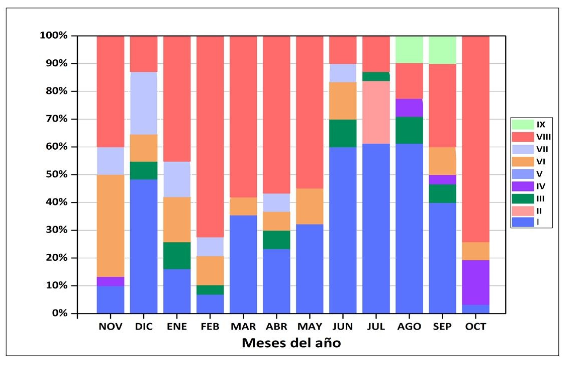Behavior of atmospheric pollutants in the presence of different synoptic situations
Main Article Content
Abstract
The prevailing synoptic conditions in one place are directly linked to the implementation values of contaminants in the atmosphere. Its study allows to determine the presence of phenomena that favor to a greater or lesser extent the accumulation of polluting substances. Taking this into account, the present investigation aimed to determine the behavior of sulfur dioxide, nitrogen and ozone dioxide in two locations in Havana under the influence of different types of synoptic situations. The data comes from automatic monitoring stations and correspond to time concentrations of the pollutants criteria. From these the daily average concentrations were calculated in µg/m3 and grouped according to the type of synoptic situation that predominated. The sampling period was from November 2015 to October 2016. To determine the relationship with the TSS, the Kruskal-Wallis H test was performed and to study this relationship in greater detail the Dunn test. The maximum average concentration values were obtained when the localities were under the weak influence of the subtropical anti -cyclone of the North Atlantic and the migratory continental anticyclones.
Downloads
Article Details

This work is licensed under a Creative Commons Attribution-NonCommercial 4.0 International License.
Those authors who have publications with this journal accept the following terms of the License Attribution-NonCommercial 4.0 International (CC BY-NC 4.0):
You are free to:
- Share — copy and redistribute the material in any medium or format
- Adapt — remix, transform, and build upon the material
The licensor cannot revoke these freedoms as long as you follow the license terms.
Under the following terms:
- Attribution — You must give appropriate credit, provide a link to the license, and indicate if changes were made. You may do so in any reasonable manner, but not in any way that suggests the licensor endorses you or your use.
- NonCommercial — You may not use the material for commercial purposes.
- No additional restrictions — You may not apply legal terms or technological measures that legally restrict others from doing anything the license permits.
The journal is not responsible for the opinions and concepts expressed in the works, they are the sole responsibility of the authors. The Editor, with the assistance of the Editorial Committee, reserves the right to suggest or request advisable or necessary modifications. They are accepted to publish original scientific papers, research results of interest that have not been published or sent to another journal for the same purpose.
The mention of trademarks of equipment, instruments or specific materials is for identification purposes, and there is no promotional commitment in relation to them, neither by the authors nor by the publisher.
References
Bolufé, J., Guevara, V. A., León, A., Rivero, A., León, L. González, Y., Cuesta, O. (2016). Efectos del clima y la calidad del aire en la crisis aguda de asma bronquial en La Habana (Proyecto “Influencia de la variabilidad del clima y la calidad del aire en algunas enfermedades crónicas no transmisibles en la región occidental de Cuba”). Informe de Resultado. La Habana, Cuba: Instituto de Meteorología, Ministerio de Ciencia, Tecnología y Medio Ambiente.
Cremata, L. (2018). Evaluación económica - ambiental de sistemas de captura de gases en pequeñas centrales termoeléctricas. Instituto Superior de Tecnologías y Ciencias Aplicadas, (UH). Tesis presentada en opción al Título Académico de Máster en Ciencias de la Gestión Ambiental.
Cuesta, O., Bolufé, J., Sosa, C., Carrillo, E.R., Madrazo, J. (2018). Contaminación atmosférica por fuentes móviles en la calle Reina, La Habana. Revista Cubana de Meteorología, Vol.23, No.1, pp.78-88, 2017, ISSN: 0864-151X.
Fonseca, M. (2018). Estudio del impacto en la calidad del aire de las fuentes puntuales en la ciudad de Pinar del Río. Revista Brasileira de Meteorología [Internet]. 2013 [citado 26 Mar 2018]; 28(1):1-12. Disponible en:http://www.scielo.br/pdf/rbmet/v28n1/01.pdf
Lapinel, B. (1988). La circulación atmosférica y las características espacio temporales de las lluvias en Cuba. Tesis presentada en opción al grado científico de Candidato a Doctor en Ciencias Geográficas. La Habana, Cuba: Instituto de Meteorología, Ministerio de Ciencia, Tecnología y Medio Ambiente.
Lecha, L. B.; Paz, L. R. y Lapinel, B. (1994). Características de la circulación atmosférica sobre Cuba y sus efectos sobre el clima local. En, El clima de Cuba. (pp.19 – 41). La Habana: Ed. Academia.
López, R., Bolufé, J., Sosa, C., García, E., Manso, R., Cuesta, O. (2016). Composición iónica de la lluvia y tipos de situaciones sinópticas en Cuba: Efectos en la contaminación atmosférica. En, Revista Cubana de Meteorología, no2, pp.141 – 149.
Ramírez, J. (1989). Estudio de las variaciones en las concentraciones de ozono troposférico en Cuba y su vinculación con algunos fenómenos meteorológicos. Tesis de Doctorado en Ciencias Geográficas, Universidad de La Habana, La Habana, Cuba, 100p.
Wayne, D. (1991). Estadísticas no paramétricas y de libre distribución. En, Bioestadística. Base para el análisis de las ciencias de la salud. (pp.503 – 557). México, D.F.: Ed. Simusa.

